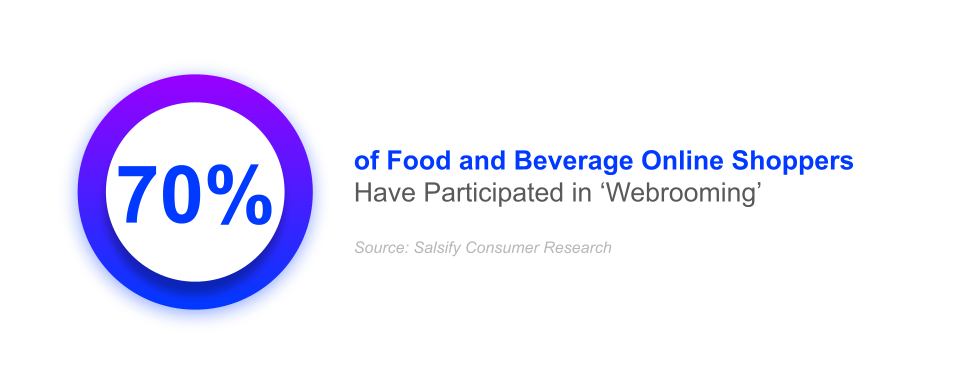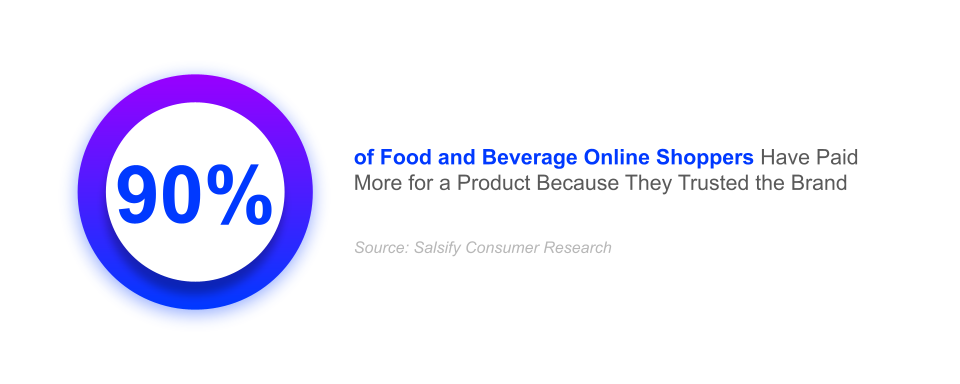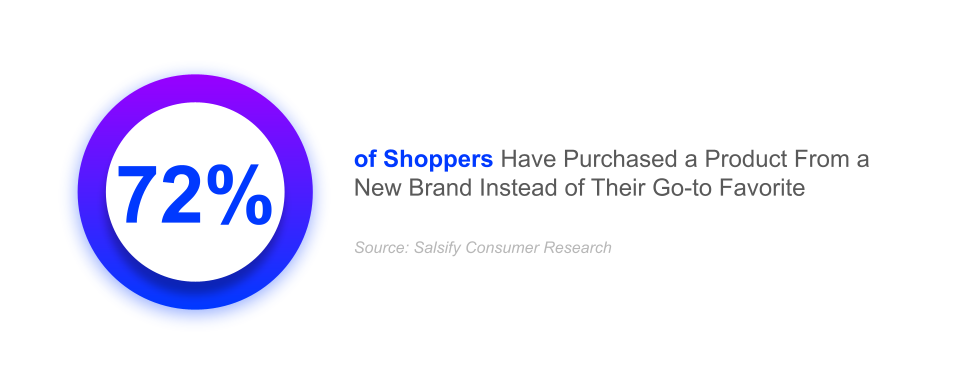Research Spotlight: Buying Behavior Trends of Food and Beverage Online Shoppers
Written By: Yvonne Bertovich
Buying journeys are complex, rarely moving from point A to point B without an alphabet soup of touchpoints in between.
And how modern shoppers move — where and how they’re discovering, researching, and buying products, for example — can be difficult for brands to track.
However, for brands interested in online food and beverage shoppers and their buying behavior, there’s no need to throw spaghetti at the wall to see what sticks.
This post decodes the shopping habits of these consumers, backed by data from Salsify’s “2025 Consumer Research” report, a survey of nearly 2,000 U.S. and U.K. shoppers.
Where Do Food and Beverage Shoppers Discover New Products and Brands?
If you’re trying to appeal to a broader audience that buys food and beverages online, the best approach is often the simplest: Start with where consumers find them.
Here’s where food and beverage shoppers discover new products and brands:
- 67% use online marketplaces (e.g., Amazon)
- 62% use search engines (e.g., Google)
- 57% use social media (e.g., TikTok, Instagram, YouTube)
- 55% go to physical retail stores
- 54% use recommendations from friends or family
Online food and beverage shoppers are more likely (up to 10%) to use marketplaces, search engines, and social media than other shoppers, giving brands a clearer picture of where to focus their marketing efforts.
Buying Behavior Tip: Spice It Up on Social Media
Shopping isn’t something consumers need to go and do anymore; it’s essentially always-on.
This behavior is also called ambient shopping — making an online purchase while doing something else, like casually browsing social media or watching a show, without intentionally searching for that product — and 73% of food and beverage online shoppers have done it, according to Salsify research.
Shoppers taking a scroll break on Instagram or TikTok may not be actively searching for a new brand of home-brewed coffee or protein-rich snack, but it could be the perfect place to pique their interest.
Social media also screams virality: If you’re looking to make a splash with an influencer collab or a limited edition flavor, go social.
Where Do Food and Beverage Shoppers Research Products?
Search engines and online marketplaces are not only the most popular research channels among online food and beverage shoppers, but this group is also 6% more likely to use them to investigate brands and products than general shoppers.
Here’s where food and beverage shoppers primarily research new products and brands:
- 71% use search engines (e.g., Google)
- 60% use online marketplaces (e.g., Amazon)
- 52% go to physical retail stores
- 50% have conversations with friends or family
- 46% use social media (e.g., TikTok, Instagram, YouTube)
Competition is fierce across search engines and marketplaces, so brands need a multi-pronged approach that addresses nuanced shopper searches — such as dietary needs or family brands that value the environment — to stand out.
Buying Behavior Tip: Get Specific, Share Your Brand Story
Most online food and beverage shoppers typically spend 10–30 minutes researching an item before purchasing it (31%), while another 30% spend 30 minutes to one hour, meaning most make quick decisions.
Ensure your product detail pages (PDPs) offer comprehensive, yet easily digestible details about your products, such as gluten-free or organic labels on direct-to-consumer sites, and that all retailer requirements are met.
Consider adding more detailed content on product labels and packaging or your brand site that features your brand story or values. Digging deeper into what makes your brand and the people who work there unique often results in more authentic connections with customers.
Where Do Food and Beverage Shoppers Buy Products?
Technology has allowed food and beverage buying to evolve dramatically — local, fast delivery is possible for perishable products, and long-distance shipping has become more reliable. Food and beverage shoppers have more online options than ever.
Here’s where food and beverage shoppers primarily buy new products:
- 74% buy on online marketplaces (e.g., Amazon)
- 58% buy in physical retail stores
- 39% from search engines (e.g., Google)
- 38% retail websites (e.g., Macy’s, Target)
- 36% social media (e.g., TikTok Shop, Instagram Shopping)
Buying Behavior Tip: Keep Info and Inventory Up to Date Online
Online food and beverage shoppers are hungry for information before they head to stores, with 70% having webroomed — researching a product online before buying it in a physical store.

According to a report by Retail Systems Research and Jumpmind, Inc. — a retail technology solutions provider — 87% of consumers want the same access to product information in-store that they get in the digital world.
Therefore, keeping your product information, like inventory, up-to-date is crucial to keep sales flowing. Nearly 60% of shoppers will purchase a different product from another brand if a product from their typical go-to brand is out of stock, according to Salsify’s “Ecommerce Pulse Report: Q4 2025.”
Top ‘Whys’ for Food and Beverage Buys
The where has been covered, but what are some other factors driving buys for food and beverage shoppers?
Here’s why food and beverage shoppers have purchased a product online:
- 42% because a social media influencer recommended it
- 39% because it was trending on social media
- 36% bought from a live stream shopping event (e.g., TikTok LIVE, Instagram Live Shopping)
Buying Behavior Tip: Infuse More User-Generated Content
Showing real foodies’ excitement across the digital shelf by infusing more user-generated content (UGC), like video reviews and testimonials, can expand your reach, build authority, and improve your reputation.
AI shopping and search tools actively feed off this content. They’re looking for real conversations, detailed FAQs, recipes, and the like to serve up as results. Fuel their recommendations by making this content plentiful and easy to find.
Don't have enough content to link to? Consider a campaign to encourage feedback from your customers or a partnership with an influencer or two (even micro influencers can make a big impression).
Data shouldn’t be hard to gather, either, as 63% of shoppers have left a product rating or review in the last year, with most (42%) doing so simply to help other shoppers make informed decisions, according to Salsify research.
What Makes Food and Beverage Online Shoppers Trust a Brand?
Brand trust means looser belts for online food and beverage shoppers. The majority (90%) have paid more for a product because they trusted the brand, making reputation management crucial, and more dire on sites like Reddit.

Here’s what makes a brand trustworthy according to food and beverage online shoppers:
- 76% say product quality and value
- 71% say brand reputation
- 66% say customer service and experience
- 54% say positive customer ratings and reviews
- 51% say high-quality product content (e.g., product images and descriptions)
Product quality and value are significantly more important for online food and beverage shoppers than for other shoppers, as is high-quality product content. This underscores the need for PDPs and brand content to shine across the digital shelf.
Buying Behavior Tip: ‘Minor’ Errors Impact Trust in a Big Way
Speaking of PDPs that shine, there are plenty of ways food and beverage brands can read as lackluster and, thus, untrustworthy.
Nearly 60% of food and beverage online shoppers abandon a sale online due to incomplete or poorly written product titles and descriptions, and 57% due to inconsistent product information across different websites.
These may seem like minor errors, but they can cost you dearly. To combat them, you need a central source of truth. And not just any old central source of truth, but one that’s powerful enough to help you keep your content correct and optimized on all of your product pages across retailers.
It’s the perfect reason to adapt your tech to consumer trends.
How To Optimize Product Experiences for Food and Beverage Online Shoppers
There are good PDPs, and then there are optimized PDPs. Learning what elements are most important to food and beverage online shoppers can give you an edge.
Here’s what product page elements are extremely important to food and beverage online shoppers:
- 55% say pricing and availability
- 46% say product images and videos
- 45% say product titles and descriptions
- 41% say customer ratings, reviews, and UGC
- 25% say enhanced content (e.g., comparison charts, feature tours, brand content)
Buying Behavior Tip: Modernize Your Personalization Efforts
Sure, PDPs vary across brands and retailers, but modern consumers increasingly expect consistent, compelling experiences. And shoppers are less loyal, with 72% purchasing a product from a new brand instead of their go-to favorite, according to Salsify research.

To combat this, imagine creating product pages personalized for specific buyer personas in minutes. It’s no pipedream: With the right tools and a little AI, it’s possible.
For example, you can tailor recommendations to a young dad looking to grill healthy, simple meals for his daughter’s soccer team. Or, a busy dog mom with allergies and a sweet tooth.
Fill Up on More Buying Behavior Insights
It can be challenging to cook up the right content for shoppers who buy food and beverages online. But knowing where and why they purchase can help you curate product experiences that leave them full.
Pump up the personality on social, infuse UGC across channels, and keep product information polished on all PDPs — that’s your recipe for success.
Ecommerce Pulse Report: Q4 2025
Looking for the freshest batch of consumer research, expert insights, and top industry trends? Check out the latest ecommerce pulse report.
READ MOREWritten by: Yvonne Bertovich
Yvonne Bertovich (she/her) is a senior content marketing specialist at Salsify, reporting from Tampa, Florida. With a longtime passion for research, she enjoys flexing her perspective on ecommerce, trends in consumer behavior, and health and wellness.
Recent Posts
How Many Digital Sales Channels Do Shoppers Review Before Purchasing Products?
What the Data Says About Consumer Interest in AI Shopping Agents
How Retailers Can Use Geolocation To Create Personalized Shopping Experiences
Subscribe to the Below the Fold Newsletter
Standing out on the digital shelf starts with access to the latest industry content. Subscribe to Below the Fold, our monthly content newsletter, and join other commerce leaders.

.svg)